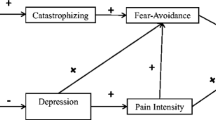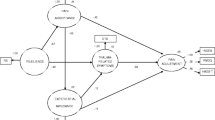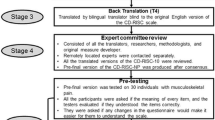Abstract
Purpose
Recent attention has focused on resilience as an important process in the experience and management of chronic pain. In this context, resilience is considered as a psychological factor that promotes adaptive responses to pain and pain-related life adversities. Current research suggests that it is a relevant variable in the prediction of pain adjustment among chronic pain patients. Recently, it was adapted the Resilience Scale to patients suffering chronic musculoskeletal pain (RS-18). The aims of this study were to confirm the internal structure of the RS-18 and to present new empirical evidence regarding its validity.
Methods
A sample of 592 patients with chronic musculoskeletal back pain completed a battery of instruments to assess resilience, anxiety sensitivity, catastrophizing, fear-avoidance beliefs, hypervigilance, pain acceptance, and pain adjustment variables (pain intensity, emotional distress, functional impairment, and daily functioning).
Results
Confirmatory factor analysis supported the validity of the RS-18 and a single-factor solution. A series of moderated multiple regression analysis showed that resilience is a relevant psychological variable that not only independently predicts better pain adjustment, but also moderates the relationships between several psychological pain-related variables and pain adjustment variables.
Conclusions
These findings give empirical support to the consideration of resilience as a protective variable in chronic pain adjustment and highlight the consideration that improving resilient behaviour could be an important target for the treatment of pain patients.
Similar content being viewed by others
Abbreviations
- AIC:
-
Akaike information criterion
- ASI:
-
Anxiety Sensitivity Index
- BCC:
-
Browne–Cudeck criterion
- CFI:
-
Comparative fit index
- CPAQ:
-
Chronic Pain Acceptance Questionnaire
- FABQ:
-
Fear-Avoidance Beliefs Questionnaire
- HADS:
-
Hospital Anxiety and Depression Scale
- IFI:
-
Impairment and Functioning Inventory
- NNFI:
-
Non-normed fit index
- PCS:
-
Pain Catastrophizing Scale
- PVAQ:
-
Pain Vigilance and Awareness Questionnaire
- RMSEA:
-
Root mean square error of approximation
- RS:
-
Resilience Scale
- TLI:
-
Tucker–Lewis index
References
West, C., Stewart, L., Foster, K., & Usher, K. (2012). The meaning of resilience to persons living with chronic pain: An interpretive qualitative inquiry. Journal of Clinical Nursing, 21, 1284–1292.
Yeung, E. W., Arewasikporn, A., & Zautra, A. J. (2012). Resilience and chronic pain. Journal of Social and Clinical Psychology, 31, 593–617.
Murray, K., & Zautra, A. J. (2011). Community resilience: Fostering recovery, sustainability, and growth. In M. Ungar (Ed.), The social ecology of resilience: A handbook of theory and practice (pp. 337–346). New York: Springer.
Evans, S., & de Souza, L. (2008). Dealing with chronic pain: Giving voice to the experience of mothers with chronic pain and their children. Qualitative Health Research, 18, 489–500.
Sturgeon, J. A., & Zautra, A. J. (2010). Resilience: A new paradigm for adaptation to chronic pain. Current Pain Headache Reports, 14, 105–112.
Sturgeon, J. A., & Zautra, A. J. (2013). Psychological resilience, pain catastrophizing, and positive emotions: Perspectives on comprehensive modelling of individual pain adaptation. Current Pain Headache Reports, 17, 317–325.
Block, J., & Kremen, A. M. (1996). IQ and ego-resiliency: Conceptual and empirical connections and separateness. Journal of Personality and Social Psychology, 70, 349–361.
Connor, K. M., & Davidson, J. R. T. (2003). Development of a new resilience scale: The Connor-Davidson Resilience Scale (CD-RISC). Depression and Anxiety, 18, 76–82.
Wagnild, G. M., & Young, H. M. (1993). Development and psychometric evaluation of the resilience scale. Journal of Nursing Measurement, 1, 165–178.
Ruiz-Párraga, G. T., López-Martínez, A. E., & Gómez-Pérez, L. (2012). Factor structure and psychometric properties of the Resilience Scale in a chronic musculoskeletal pain sample. Journal of Pain, 13, 1090–1098.
Jensen, M. P., Turner, P., Romano, J. R., & Fisher, L. D. (1999). Comparative reliability and validity of chronic pain intensity measures. Pain, 83, 157–162.
Reiss, S., Peterson, R. A., Gursky, M., & McNally, R. J. (1986). Anxiety sensitivity, anxiety frequency and the prediction of fearfulness. Behavior Research and Therapy, 24, 1–8.
Sandín, B., Chorot, P., & McNally, R. J. (1996). Validation of the Spanish version of the Anxiety Sensitivity Index in a clinical sample. Behavior Research and Therapy, 34, 283–290.
Sullivan, M. J. L., Bishop, S. R., & Pivik, J. (1995). The Pain Catastrophizing Scale: Development and validation. Psychological Assessment, 7, 524–532.
Muñoz, M., & Esteve, R. (2005). Reports of memory functioning by chronic pain patients. Clinical Journal of Pain, 21, 287–291.
Waddle, G., Newton, M., Henderson, I., Somerville, D., & Main, C. J. (1993). A fear-avoidance beliefs questionnaire (FABQ) and the role of fear-avoidance beliefs in chronic low back pain and disability. Pain, 52, 157–168.
Kovacs, F. M., Muriel, A., Abraira, V., Medina, J. M., & Olabe, J. (2006). Psychometric characteristics of the Spanish Version of the FABQ. Spine, 31, 104–110.
McCracken, L. M. (1997). Attention to pain in persons with chronic pain: A behavioural approach. Behaviour Therapy, 28, 271–284.
Esteve, R., Ramírez-Maestre, C., & López-Martínez, A. E. (2013). Empirical evidence of the validity of the Spanish version of the Pain Vigilance and Awareness Questionnaire (PVAQ). International Journal of Behavioral Medicine, 20, 59–68.
McCracken, L. M., Vowles, K. E., & Eccleston, C. (2004). Acceptance of chronic pain: Analysis and a revised assessment method. Pain, 107, 159–166.
Bendayán, R., Esteve, R., & Blanca, M. J. (2012). New empirical evidence of the validity of the Chronic Pain Acceptance Questionnaire: The differential influence of activity engagement and pain willingness on adjustment to chronic pain. British Journal of Health Psychology, 17, 314–326.
Zigmond, S., & Snaith, R. P. (1983). The Hospital Anxiety and Depression Scale. Acta Psychiatrica Scandinavica, 67, 361–370.
Quintana, J. M., Padierna, A., Esteban, C., Arostegui, I., Bilbao, A., & Ruiz, I. (2003). Evaluation of the psychometric characteristics of the Spanish version of the Hospital Anxiety and Depression Scale. Acta Psychiatrica Scandinavica, 107, 216–221.
Ramírez-Maestre, C., & Valdivia, Y. (2003). Evaluación del funcionamiento diario en pacientes con dolor crónico. Psicología Conductual, 11, 283–291.
Hu, L., & Bentler, P. M. (1999). Cut-off criteria for fit indexes in covariance structure analysis: Conventional criteria versus new alternatives. Structural Equation Modeling, 6, 1–55.
Kline, R. B. (2005). Principles and practice of structural equation modelling (2nd ed.). New York: Guilford Press.
Byrne, B. M. (2001). Structural equation modeling with AMOS: Basic concepts, applications, and programming. Mahwah, NJ: Lawrence Erlbaum Associates.
Cohen, J. A. (1992). Power primer. Psychological Bulletin, 112, 155–159.
Wagnild, G. M. (2009). The resilience scale user’s guide. Resource document. Accessed May 14, 2013 from http://www.resiliencecenter.com.
Sturgeon, J. A., Zautra, A. J., & Arewasikporn, A. (2014). A multilevel structural equation modelling analysis of vulnerabilities and resilience resources influencing affective adaptation to chronic pain. Pain, 155, 292–298.
Crombez, G., Eccleston, C., Van Damme, S., Vlaeyen, J. W. S., & Karoly, P. (2012). Fear-avoidance model of chronic pain: The next generation. Clinical Journal of Pain, 28, 475–483.
Hasenbring, M. I., & Verbunt, J. A. (2010). Fear-avoidance and endurance-related responses to pain: New models of behavior and their consequences for clinical practice. Clinical Journal of Pain, 26, 747–753.
López-Martínez, A. E., Ríos-Velasco, L., Ruiz-Párraga, G. T., Esteve, R., & Sánchez-Reyna, A. (2009). The role of resilience and acceptance versus catastrophizing and pain-related fear in chronic pain adjustment. European Journal of Pain supp., 13, 970.
Ramírez-Maestre, C., Esteve, R., & López-Martínez, A. E. (2012). The path to capacity: Resilience and spinal chronic pain. Spine, 37, E251–E258.
Asmundson, G. J., Norton, P. J., & Vlaeyen, J. W. S. (2004). Fear-avoidance models of chronic pain: an overview. In G. J. Asmundson, J. W. S. Vlaeyen, & G. Crombez (Eds.), Understanding and treating fear of pain (pp. 3–24). Oxford: Oxford University Press.
Smith, B. V., & Zautra, A. J. (2008). Vulnerability and resilience in women with arthritis: Test of a two-factor model. Journal of Consulting and Clinical Psychology, 76, 799–810.
Vlaeyen, J. W. S., & Linton, S. J. (2000). Fear avoidance and its consequences in chronic musculoskeletal pain: A state of the art. Pain, 85, 317–332.
Acknowledgments
This work was partly supported by a grant from the Spanish Ministry of Economy and Competitiveness (PSI2013-42512-P).
Conflict of interest
This work has not received financial arrangements that may represent a possible conflict of interest.
Author information
Authors and Affiliations
Corresponding author
Rights and permissions
About this article
Cite this article
Ruiz-Párraga, G.T., López-Martínez, A.E., Esteve, R. et al. A confirmatory factor analysis of the Resilience Scale adapted to chronic pain (RS-18): new empirical evidence of the protective role of resilience on pain adjustment. Qual Life Res 24, 1245–1253 (2015). https://doi.org/10.1007/s11136-014-0852-z
Accepted:
Published:
Issue Date:
DOI: https://doi.org/10.1007/s11136-014-0852-z




